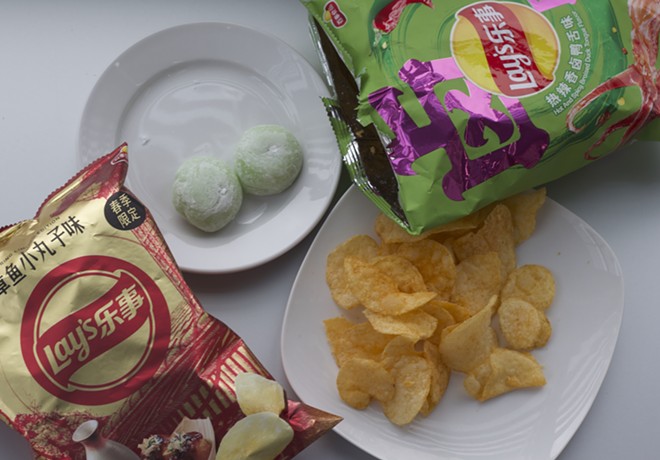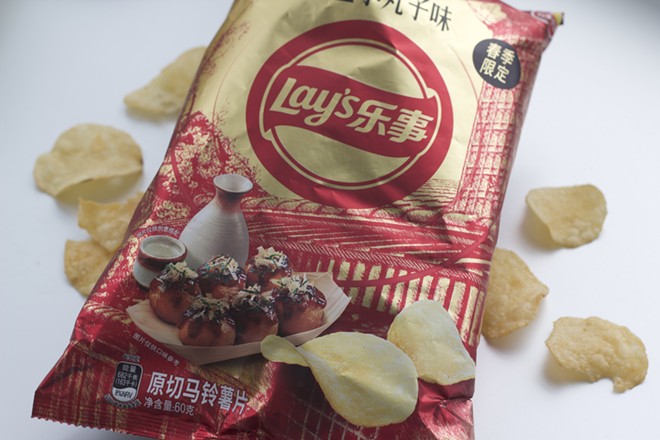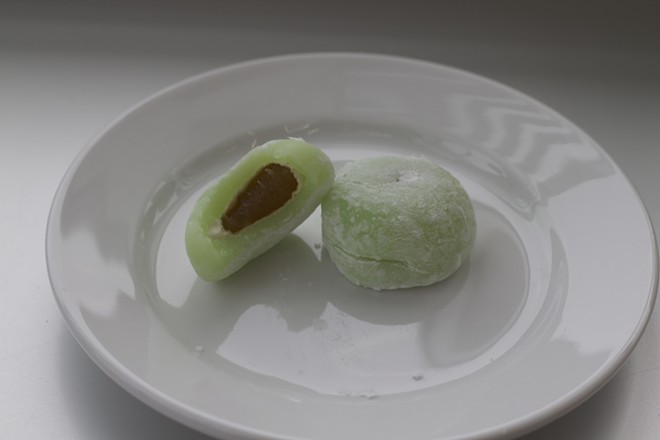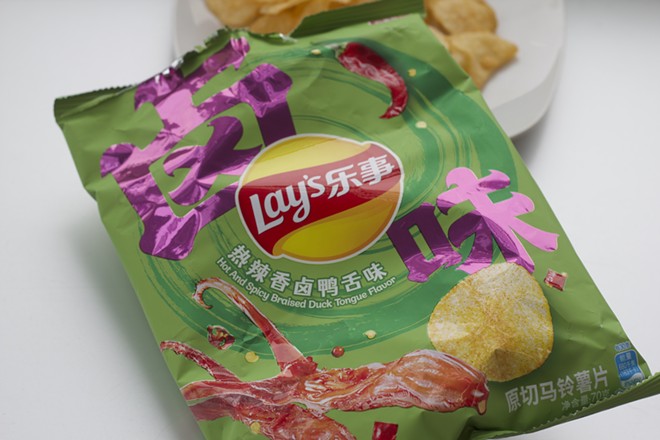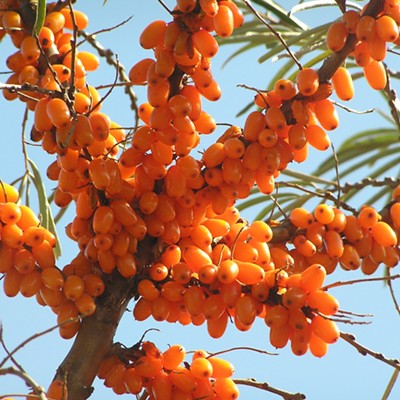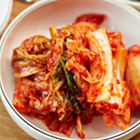This is an installment of the Inlander's yearlong project "Around the World in 80 Plates," a quest to find 80 foods and drinks in Spokane representing 80 different places. Read the introduction to the project here.
Count of dishes/places: 5
I’m not a big snack person. Mostly because I can’t control myself around salty, crispy, empty calories. It’s easier for me to cut them out completely than partake in a reasonable manner. In my childhood home, kitchen cupboards were filled with apples and corn flakes because my mom thought avoiding fruit snacks and Doritos would teach me restraint. Instead, I raided my friends' houses and never learned self-control.
I am especially unhinged around Italian four cheese Cheez-Its. They technically have more to do with Ohio than Italy, but the hints of Parmesan make me feel like I’m in a monastery with Benedictine monks in Parma or Reggio Emilia. Suddenly, I’m more sophisticated than I thought, scarfing down handfuls of crackers.
Because snacks aren’t about the actual snack you’re eating. Snacks are about how that snack makes you feel.
This week, I went to Full Stop Gas, Grocery & Liquor on Wellesley Avenue to check out their selection of imported snacks by Exotic Vending. Across from the milkshake machine, half of Aisle 1 is taken up by ramen in anime packaging, Lay’s marketed in Thai or Chinese, and a rainbow assortment of mochi.
These snacks pour out of factories in manufacturing towns. A Lay’s conveyor belt in the southern Guangdong province carrying spicy crayfish chips has as little to do with Sichuan crayfish as Dayton has to do with the origins of Parmesan cheese. But the flavors the snacks are riffing off of are legitimate, and sometimes inaccessible or unheard of in other parts of the world except in potato chip form.
So I’m including these snacks in our Around the World project, not because they’re authentic representations of traditional dishes, but because they’re the first introduction I’ve had to these foods, which has made me research new ingredients and taste new things and feel like I’m traveling to new places, even though I’m just scarfing down handfuls of chips.
TAKOYAKI LAY’S (OSAKA, JAPAN)
Takoyaki translates to English as “grilled octopus,” but it refers to festive fried dough balls filled with octopus, commonly thought to have been created on the streets of Osaka. At takoyaki stands or shops, you can watch vendors make the golf-ball sized snacks that offer a blast of sweet, salty and umami flavors. Apparently, the hardest part is not stuffing them into your mouth while they’re still burning hot.
To fry them, special grill pans that look a little like half an egg carton are heated over open flames. Each divot gets filled with dough and octopus, plus other fillings like pickled ginger and leftover tempura flakes. Once the outside is crispy, while the inside is still soft, about eight of them are plopped in a portable container and topped with seaweed, katsuobushi (dried fish flakes), mayo and a special takoyaki sauce. Ditch the chopsticks and spear them with a toothpick or bamboo skewer for an easy eating experience.
Turns out, you can find takoyaki at most Japanese restaurants in and around Spokane, but I never thought to order them until now. What was I waiting for? I love octopus, and surely, fried dough only makes everything taste better.
The only real resemblance these Lay’s chips have to actual takoyaki is that they, too, are fried. When I tore open the bag, I swore I smelled barbecue. That’s because the chip mostly tries to mimic the flavor of the takoyaki sauce, a sweet-savory brown sauce that isn’t so far removed from A1.
With my eyes closed, I would’ve guessed they were some kind of sweet barbecue chip with a little less punch than the classic black Lay’s bag. Pleasant, tasty, but nothing to make me think of octopus or feel like I was strolling the streets of Osaka.
HAMI MELON MOCHI (HAMI, CHINA)
These mochi are technically manufactured in Taiwan, but they’re flavored after Hami melons, famous oblong, cantaloupe-like melons from the Xinjiang Uyghur Autonomous Region of northwestern China.
Hami is a city in Xinjiang tucked between mountains and abutting the Gobi Desert. Water trickling down from the peaks and dramatic temperature shifts between day and night make it a perfect place to grow melons. There are over 200 varieties of Hami melons, and 2023 saw the 17th annual Hami Melon Festival dedicated to the region’s most beloved fruit. The festival includes dancing, singing, plenty of melon tasting, and melon-themed competitions.
Most of the melons are very sweet and crisp. In traditional Chinese medicine, they’re thought to cool the body, reduce lung irritation and restore qi. They’re also affectionately called snow melons because of the melted snow that waters them each year.
Xinjiang is also where the United Nations has accused China of systematic human rights abuses against the Uyghur minority, a Muslim community that speaks Turkic languages. China rejects the accusations, but does acknowledge using "re-education camps" to resettle “religious extremists.” The population of the region is over 25 million, and other smaller Muslim minorities also live in Xinjiang, including Kazakhs, Mongols, Hui, Tajiks and Kyrgyz.
Mochi itself is a traditional Japanese treat, made from a glutinous rice dough that forms a soft, chewy cake when it’s steamed. These mochi are squishy and light in flavor, sweet but not overly so. The jelly in the middle promises the most concentrated melon flavor.
It seems right that these treats aren’t too sweet, considering the bitter current events in the melon's homeland. And it’s touching that other countries would choose to honor the Hami melon with this mochi. Hami melon varieties have started to be cultivated in other parts of the world, including the Imperial Valley in California, but they’ll never be snow melons without the clear, cold water from the Tian Shan mountains.
BRAISED DUCK TONGUE LAY’S (GUANGZHOU, CHINA)
Cantonese cooking prioritizes simple, fresh foods and using every part of an animal. It’s no wonder, then, that if duck meat is on a Cantonese menu, duck tongue would be, too. Canton is an old name for Guangzhou, the capital of Guangdong province and the largest city in southern China. The Cantonese region typically includes Hong Kong and Macau, too. With lots of agriculture and aquaculture, the cuisine focuses on letting natural flavors shine without too much spice.
Slow-cooking duck tongues, which are much different than duck meat, produces an entree that is wildly flavorful with just a few seasonings. Duck tongues are mostly fat, and therefore provide a rich base for whatever spices are on top. They’re also sometimes stir fried or deep fried for a crispy outer layer and a velvety interior, although there are small, chewable bones in the tongue (as there are in all avian tongues). But Lay’s chooses to pay homage to slow-roasted (or braised) duck tongues for especially deep flavors.
You’d be hard pressed to find duck tongues in Spokane, unless you order them directly to your door. Duck meat prices aren’t tracked by the USDA like poultry, pork, or beef, but according to local chefs, they’ve been going up recently. Something as gourmet and trendy as duck tongue probably follows suit.
A pound of duck tongues from Farm Fresh Duck in Pennsylvania costs $18.70, and a five-pound package goes for $92.00. That is, after all, a lot of duck tongues. On the other hand, an imported bag of Hot and Spicy Braised Duck Tongue Lays is more expensive than a typical bag of chips, but way less than actual duck tongues.
The spice is heavier on the potato chip than it would probably be on a traditional, spice-lite Cantonese duck tongue. But there’s something else under the chili heat that’s definitely, well, duck. Maybe it’s the power of persuasion, but I couldn’t stop imagining kissing a duck as I was crunching the chip.
And if you think that’s weird, take a second look at the picture of the duck tongue on the packaging. It’s got these gnarly, antennae-like frills coming out the back, presumably the two thin muscles that attach the tongue to each side of the throat. According to avian tongue experts, a duck’s tongue has more to do with moving food down its throat than speaking— well, quacking.
But the consensus around the office (among people who are much more snack-experienced than me) is that the spicy duck tongue chips are good. So don’t let the picture freak you out. Maybe you’ll be inspired to try some Cantonese cooking basics in your own kitchen. Or even order your own duck tongues. Thanks, Lay’s! ♦
Have an idea for what I should eat next? Wanna make me a favorite dish from your hometown? Send 80 Plates tips and ideas to [email protected].
